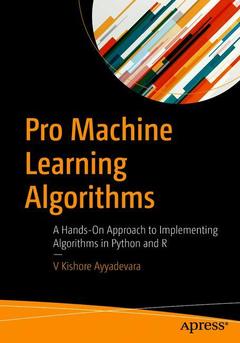Chapter 1: Basic statistics
Chapter Goal: Build the statistical foundation for machine learning
No of pages : 20
Sub -Topics
1. Introduction to various statistical functions
1. Introduction to distributions
2. Hypothesis testing
3. Case classes
Chapter 2: Linear regression
Chapter Goal: Help the reader master linear regression with the theory & practical concepts
No of pages: 25
Sub - Topics
1. Introduction to regression
2. Least squared error
3. Implementing linear regression in Excel & R & Python
4. Measuring error
Chapter 3: Logistic regression
Chapter Goal: Help the reader master logistic regression with the theory & practical concepts
No of pages: 25
Sub - Topics:
1. Introduction to logistic regression
2. Cross entropy error
3. Implementing logistic regression in Excel & R & Python
4. Area under the curve calculation
Chapter 4: Decision tree
Chapter Goal: Help the reader master decision tree with the theory & practical concepts
No of pages: 40
Sub - Topics:
1. Introduction to decision tree
2. Information gain
3. Decision tree for classification & regression
4. Implementing decision tree in Excel & R & Python
5. Measuring error
Chapter 5: Random forest
Chapter Goal: Help the reader master random forests with the theory & practical concepts
No of pages: 15
Sub - Topics:
1. Moving from decision tree to random forests
2. Implement random forest in R & Python using decision tree functionalities
Chapter 6: GBM
Chapter Goal: Help the reader master GBM with the theory & practical concepts
No of pages: 20
Sub - Topics:
1. Understanding gradient boosting process
2. Difference between gradient boost & adaboost
3. Implement GBM in R & Python using decision tree functionalities
Chapter 7: Neural network
Chapter Goal: Help the reader master neural network with the theory & practical concepts
No of pages: 30
Sub - Topics:
1. Forward propagation
2. Backward propagation
3. Impact of epochs and learning rate
4. Implement Neural network in Excel, R & Python
Chapter 8: Convolutional neural network
Chapter Goal: Help the reader master CNN with the theory & practical concepts
No of pages: 30
Sub - Topics:
1. Moving from NN to CNN
2. Key parameters within CNN
3. Implement CNN in Excel & Python
Chapter 9: RNN
Chapter Goal: Help the reader master RNN with the theory & practical concepts
No of pages: 25
Sub - Topics:
1. Need for RNN
2. Key variations of RNN
3. Implementing RNN in Excel & Python
Chapter 10: word2vec
Chapter Goal: Help the reader master word2vec with the theory & practical concepts
No of pages: 20
1. Need for word2vec
2. Implementing word2vec in Excel & Python
Chapter 11: Unsupervised learning - clustering
Chapter Goal: Help the reader master clustering with the theory & practical concepts
No of pages: 15
Sub - Topics:
1. k-Means clustering
2. Hierarchical clustering
3. Implement clustering in Excel, R & Python
Chapter 12: PCA
Chapter Goal: Help the reader master PCA with the theory & practical concepts
No of pages: 15
Sub - Topics:
1. Dimensionality reduction using PCA
2. Implement PCA in Excel, R & Python
Chapter 13: Recommender systems
Chapter Goal: Help the reader master recommender systems with the theory & practical concepts
No of pages: 25
Sub - Topics:
1. user based collaborative filtering
2. Item based collaborative filtering
3. Matrix factorization
4. Implementing the above algorithms in Excel, R & Python
Chapter 14: Implement algorithms in the cloud
Chapter Goal: Help the reader understand the ways to implement algorithms in the cloud
No of pages: 30
Sub - Topics:
1. Implementing machine learning algorithms in AWS
2. Implementing machine learning algorithms in Azure
3. Implementing machine learning algorithms in GCP




